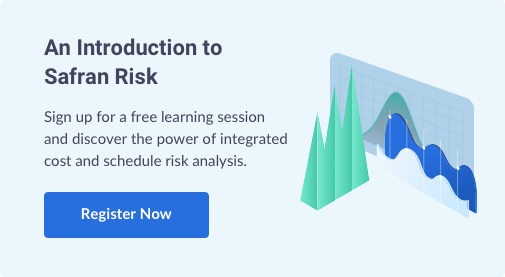Risk and resilience expert, Alexander Larsen, explains why getting the most out of Cost and Schedule Risk Analysis (CSRA), can be an immensely rewarding experience.
Step 1: Selling the full value of CSRA
Risk management is still a relatively young discipline and just twenty years ago, not much was known about it. However, it’s come a long way since then. Today, Cost and Schedule Risk Analysis (CSRA) is regularly used to improve project control on large capital projects where risks often significantly impact a project’s final cost and completion date.
But is the full value of CSRA widely understood? The true answer is not always. Senior executives often accept CSRA being used in a tick-box way, merely to feel reassured that appropriate governance is taking place, rather than appreciating the full benefits it can bring them. The project or risk manager must step up and demonstrate that CSRA can improve outcomes that senior executives care about.
“I often think of risk managers as salespeople. We must get out networking and build relationships with people. We must ‘sell’ risk management and the benefits it can bring. To do this effectively we must see what’s driving the decision makers, understand their concerns, and what’s close to their hearts right now."
-Alexander Larsen
Step 2: Proving the trustworthiness of risk data
Risk data is not always trusted or understood. This can be frustrating for risk management professionals who may have completed a thorough CSRA for a specific project or scenario, only to find the information is ignored.
To prove its value, risk managers need to explain where the data has come from, so senior level executives can see that it has been provided by trusted sources within their own organisation. The data also needs to be presented in the right way, taking account of what really matters to those making the decisions. This is where the risk manager must step up and lead the process – presenting the data in a way that decision makers will not be able to ignore.
Of course, AI systems and machine learning have enormous potential when it comes to quantifying project risks, due to their ability to process vast amounts of historic data quickly and efficiently. However, risk professionals have an even more important role to play in providing the human understanding and people skills needed to interpret the data and apply it intelligently to the current situation. Ultimately, people respond to people, so in this sense the risk manager’s role is becoming more important than ever.
Step 3: Solving relevant problems
Instead of using risk data to communicate bad news about project delays, risk management professionals should focus on finding out what senior level stakeholders really want to achieve.
It is important to ask the right questions to find out more about the concerns of the business and the main drivers for senior level executives. Asking questions such as ‘what does success look like’ and ‘what’s keeping you awake at night?’ can help to improve understanding about what is driving the interest of key stakeholders.
Presenting a risk register, comprising 50 or more risks, is never going to be the best way to get the attention of senior level executives who are generally time poor and may not have a thorough understanding of risk management processes. The risk management professional must use the data to tell a positive story about how CSRA can help to solve problems and support their vision of success. Empowering senior executives to make final decisions across your well thought through “what-if scenarios” is a great way to communicate the problem-solving capabilities of CSRA.
Step 4: Extending the uses from CSRA
In an ideal world, CSRA should be carried out at the earliest possible opportunity, preferably before a project has started.
CSRA can deliver value in a wide variety of ways. For example, it can be used at the outset to help a business to decide which projects to progress based on an assessment of their individual viability. This can be particularly helpful if, for example, a senior decision maker is invested in one specific project more than another.
Making CSRA an essential part of the risk culture of your organisation can also help to improve contractor relationships. Where necessary, it is worth spending time with individual contractors to find out more about what they want to achieve and to explain how CSRA can support them.
Using CSRA can make it easier for senior level executives at larger organisations to gain an overview of how things are going across multiple projects and make informed decisions at the portfolio level. For example, by flagging where contingency funds are most needed across multiple projects, senior level executives can reallocate accordingly to maximise value from scarce funds.
CSRA can also be applied in a more focused way to specific scenarios, for example to establish what might happen if there is a supply shortage or an inflationary price increase.
Step 5: Reporting in the right way
Once a CSRA has been completed, the data must be reported in a clear and accessible way. If using dashboards for example, it is important to consider if they are presenting the right data in the right form. Whatever reporting mechanism is selected, it must be aligned with stakeholders’ real concerns.
For the risk manager, this is the most challenging and potentially most rewarding part of CSRA. Get it right and stakeholders will react in a positive way, asking questions and starting dynamic conversations. Get it wrong and there is a real risk that stakeholders will lose interest and walk away.
How do you know if you have been successful? As a risk management professional, a key sign of success is being invited to the top table to share your expertise and insights. This is when you can be sure that the value of your risk data is truly understood.
“I had been working on a project for several weeks when I was invited to attend a Board meeting with senior level executives. They had begun to view risk as an essential part of their decision making. When this happened, I realised two things – firstly, that I had understood what they wanted correctly and secondly, that they had learned the value of risk management.”
-Alexander Larsen
Biographical note:
 Alexander Larsen is President of Baldwin Global Risk Services Ltd and founder of the Risk Guide, a website for sharing information about risk management. He also hosts ‘Risk Managers Getting Coffee’, a collection of interviews, exploring risk management cultural differences with risk managers from around the world.
Alexander Larsen is President of Baldwin Global Risk Services Ltd and founder of the Risk Guide, a website for sharing information about risk management. He also hosts ‘Risk Managers Getting Coffee’, a collection of interviews, exploring risk management cultural differences with risk managers from around the world.
With more than 20 years’ experience in countries such as Malaysia, Iraq, Saudi Arabia, UK, UAE, Pakistan and Nigeria, Alexander is an expert in the delivery of both enterprise risk management and project risk management strategies across industry sectors. He is also a fellow of the Institute of Risk Management, as well as a certified trainer and holds a degree in risk management degree.
To learn more about how you can add true value to a project, and earn the professional credibility you deserve, watch industry experts advise how at the Safran Project Risk Conference 2022, here.





